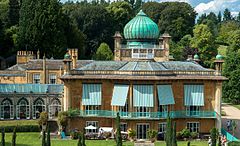Sezincote
| Sezincote | |
|---|---|
 |
|
| General information | |
| Architectural style | Neo-Mughal |
| Town or city | Gloucestershire |
| Country | England |
| Completed | 1805 |
| Client | Charles Cockerell |
| Design and construction | |
| Architect | Samuel Pepys Cockerell |
| Website | |
| Sezincote | |
Sezincote House is the centre of a country estate in Gloucestershire, England. The house was designed by Samuel Pepys Cockerell, built in 1805, and is a notable example of Neo-Mughal architecture, a 19th-century reinterpretation of 16th and 17th-century architecture from the Mughal Empire. At the time of its construction, British India was becoming the "jewel in the crown" of the world's largest empire.
Sezincote is dominated by its red sandstone colour, typical in Mughal architecture, but features a copper-covered dome instead of the typical white marble. The fenestration is composed of a sequence of extra-large windows with an arch-shape at the top. The arch, however, is not a simple or typical design, but instead a shell-like fan that is evidence of the Mughal influence. The interior design is more typical European style.
The landscape was designed by Humphry Repton. It is essentially a renaissance-style garden with elements of Hindu style, as seen in the crescent bridge with columns.
The house is in countryside 1 1⁄2 miles (2.4 km) from Moreton-in-Marsh, "set on high ground in the shelter of the Cotswolds." Colonel John Cockerell bought the estate in 1795 on his return from Bengal. After his death in 1798, his youngest brother, Charles Cockerell, inherited the property who then "employed another brother, Samuel Pepys Cockerell, to build him a house in the Indian manner."
Samuel Pepys Cockerell worked as surveyor for the British East India Company and as an apprentice to Sir Robert Taylor, where John Nash was also apprenticed. In spite of his tenure as Surveyor to the East India Company, Cockerell never travelled to India; his encounters with Mughal architecture, a building style that flourished in India in the 16th century, were strictly through the medium of drawings and engravings, such as those by Thomas Daniell (who designed the garden for his "old Indian ally" Sir Charles Cockerell and its temple, bridge, dairy and farm buildings) and his nephews.
...
Wikipedia
